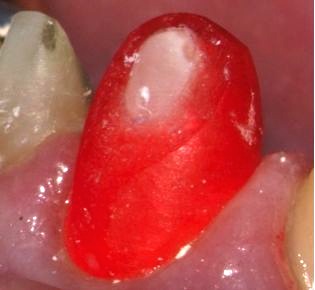Can a Reduction Coping Help?
Have you ever had to retake an impression because you did not create enough room for your lab technician? While it should be a rare occurrence, when it does happen, and sooner or later it will, it’s a huge inconvenience for you and the patient. While taking a new impression is sometimes unavoidable, in some cases a reduction coping will allow your technician to make the room they need and then allow you to match what they did when you deliver your case.
A reduction coping is simply a thin shell of resin or metal that is fabricated by your lab technician that shows you exactly where you need to reduce in the mouth. The first step in this process is for your technician to create a thin coping of resin or metal that fits over the stone model of the under-reduced preparation.
Once this is done, the next step is to adjust the stone model with this coping in place on the model by simply cutting through the resin or metal. The coping will now have a hole through it wherever the model has been adjusted. Afterwards, the technician can work with the adjusted model to make the desired restoration. Once the case is completed it is simply returned with the reduction coping. Prior to delivery the reduction coping is placed on the patient’s tooth and the tooth structure that sticks out past the coping is removed, allowing the restoration to fit properly.
The use and fabrication of a reduction coping can be simple and predictable; however, it’s important to adhere to a few simple rules to keep it that way. The first is they should only be used in cases where a small area needs to be adjusted. The next is that whatever needs to be adjusted should be removed with a straight bur in a single plane cut to ensure easy replication in the mouth.
In the rare case that you have an area that is appropriate for the use of a reduction coping but needs multi-planer reduction, one coping for each plane of reduction should be fabricated. If you’re using multiple copings for one preparation they must be made sequentially and labeled so they can be used in the proper order in the mouth. Next time you get the call from your lab that they need a little more room, ask them if a reduction coping could be used. If so, you will save you and your patient and extra appointment.
John R. Carson, DDS, PC, Spear Visiting Faculty. [ www.johnrcarsondds.com ]
SPEAR campus
Hands-On Learning in Spear Workshops
With enhanced safety and sterilization measures in place, the Spear Campus is now reopened for hands-on clinical CE workshops. As you consider a trip to Scottsdale, please visit our campus page for more details, including information on instructors, CE curricula and dates that will work for your schedule.

By: John Carson
Date: January 4, 2014
Featured Digest articles
Insights and advice from Spear Faculty and industry experts



